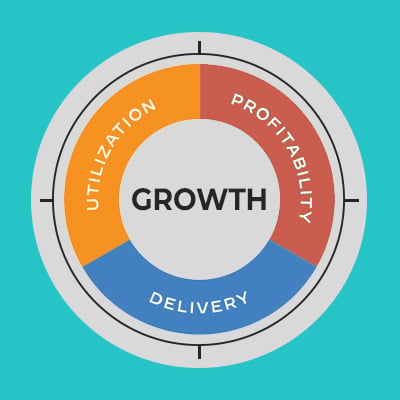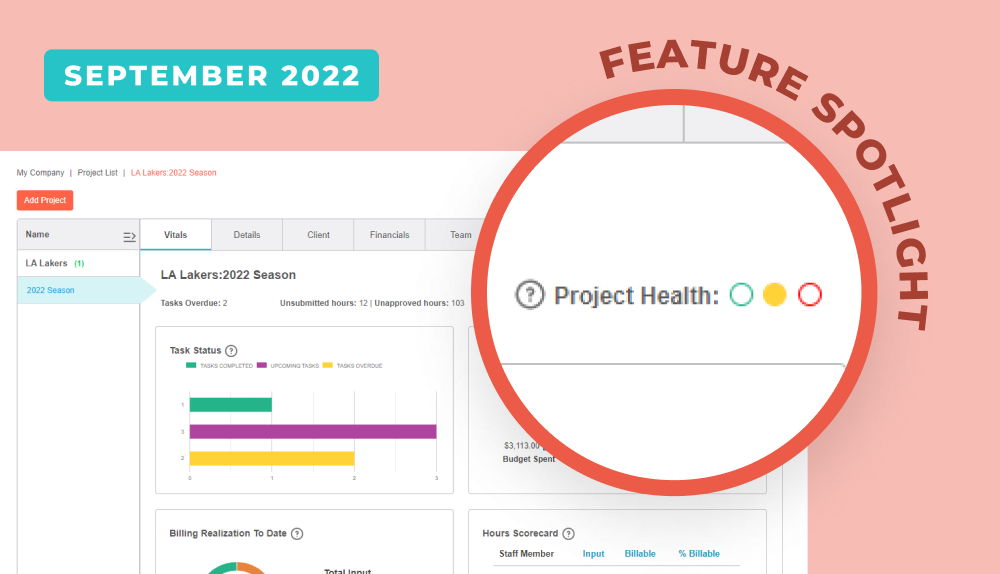
What is Resource Utilization in Project Management?
While optimal resource utilization is one key metric that has a significant impact on business growth, it is just that: one metric. Read on to learn how to stop thinking about project resource utilization in a vacuum, and how to start thinking about professional services resource management in a wholistic view that better aligns with today’s ever-changing business environment.
What Happens When Billable Resource Utilization is Improved in Isolation?
A professional services firm’s brand and its success will always be driven by talent. A services team’s ability to sell project-based work, deliver exceptional projects, and retain existing customers is a direct result of the remarkable work and robust culture driven by its people.
Solely thinking about running an organization through the lens of utilization targets, time tracking, and billable time may lead to negative repercussions, such as trying to maximize billable utilization rates as much as humanly possible without recognizing the impact on its employees. For example, staffing employees to full capacity might maximize resource utilization over a short period of time but at the expense of morale, potential burnout, and talent attrition in the long-run. This can ultimately derail revenue per employee, project profitability, and client satisfaction.
Here are some ways to stop thinking about utilization solely as the billable utilization formula and start thinking about it from a broader and more advantageous perspective.
Determine a Healthy and Optimal Resource Utilization Target
Utilization is an important component of a professional services business to get right. Many service leaders fail to recognize that utilization not only measures the value of a services team’s most valuable asset, its people, but also how efficiently that asset is being leveraged. Unlike many other businesses that offer tangible products, services firms deliver an extremely perishable product—time.
Billable hours and time spent working on a project by a highly skilled, highly paid consultant cannot be stored away and used later. As soon as those hours pass, they are either used to generate value for the organization or they are lost forever.
While leaders cannot increase the number of working hours in a day or the total hours needed to complete a project, they can figure out how to achieve optimal resource utilization in project management. The ability to achieve better utilization of resources in a healthy way can help a company gain profit and sustainably grow.
It is useful to consider how much project resource utilization is healthy for your firm. Increasing employee utilization rates increases revenue per employee, which correlates directly to the bottom line as increased profit. However, if employees are consistently staffed to nearly full capacity, you risk maximizing billable utilization in the short-term but at the expense of morale and potential burnout in the long-run.
For instance, a white paper published by Projector by BigTime focused on how to maximize employee retention presents research indicating that that two of the top reasons for burnout include time: an unmanageable workload and unreasonable time pressure. Maxing out utilization targets can ultimately derail revenue per employee and thus, project profitability.
Setting Resource Utilization Targets
An increase in utilization can significantly improve profit but only if monitored carefully to make sure it is consistently in a healthy range. Many project managers find success by setting both a minimum and a maximum resource utilization target. This helps to control overutilization and ensure that time is strategically allocated to staff development, IP creation, and other internal developments that help a firm gain a competitive advantage in the market.
When utilization targets are measured and tracked repeatedly, an organization can leverage efficient resource utilization benchmarks and project baselines to course-correct resource utilization metrics and make adjustments as needed.
Bonus: Download a free guide for more strategies on increasing the utilization of your resources to deliver projects more efficiently and more profitably.
Positively Influence the Resource Utilization Calculation
Resource Balancing
One way to improve billable utilization is to implement a process for resource-driven forecasting. Resource-driven forecasts, also known as bottom-up forecasts, allow teams to schedule all of their planned work and match the right resources to projects accordingly, using their best judgement. Planned work includes both projects in the proposal phase and also projects currently underway.
Then, an organization can translate the scheduled work into accurate, time-phased revenue forecasts, providing insight into a firm’s resource capacity to successfully deliver the work within the estimated time of completion. This transparency allows services teams to not only have a clear understanding of the project pipeline but also the ability for schedulers to optimize resource utilization rates across the firm’s project workload.
Resource-driven forecasts should be monitored on an ongoing basis and adjusted accordingly to highlight capacity shortfalls and surpluses, call attention to projects that are both ahead and behind schedule, and incorporate new work that enters the sales pipeline.
Supply and Demand Match
Once organizations have resource-driven forecasts in place, service leaders should focus on ensuring they have the right-sized company for the amount of work they are performing and the right talent for the type of projects they are delivering.
Carefully monitoring efficient resource utilization rates and resource-driven forecasts provides clarity not only into when to hire but also who to hire to balance supply and demand across both capacity and ability. Service leaders will understand if they need to hire additional resources, maintain their current employee base, or engage with contractors on an ad-hoc basis.
If hiring a full-time employee is not within an organization’s budget, it can be beneficial to supplement with contractors for the time period until there is enough billable work to justify a targeted hire. According to SAP research, 65% of executives find independent, external workers important or very important to their ability to operate at full capacity and meet market demand.
Furthermore, the Business Talent Group’s (BTG) 2021 Skills Index shows that the most in-demand skill being requested is project management. With the booming gig economy, engaging with independent contractors for a set number of hours is an attractive time resource investment for many firms.
Consistent Metrics Evaluations
Utilization rates should be examined and adjusted regularly as part of a services firm’s standardized operating model. It is helpful to establish a utilization performance benchmark within an organization and also compare to the market average. SPI Research’s Professional Services Benchmark Survey is a great starting point.
Once a benchmark is in place, make strategic changes that influence the metric, and continuously adjust and monitor utilization rates to ensure they remain both strong and healthy. Service leaders might decide to incorporate routine metrics maintenance into already occurring business practices to stay on track with better utilization of resources. For instance, incorporating a metrics review into an organization’s quarterly business performance management sessions or budget planning sessions.
Service leaders often wonder what the resource utilization formula is to calculate utilization on a project. However, it is more effective to measure utilization performance across an entire resource pool or organization, rather than honing in on individual projects. Think about how to slice utilization reports across different resource management metrics such as by department, team, title, skillset, etc. This type of resource allocation measurement is something that a resource forecasting template in Excel alone cannot achieve.
Small improvements in billable utilization make a significant difference when scaled to the size of typical professional services organizations. As a resource utilization example, a 7% improvement in utilization can translate into a few extra millions of dollars in incremental revenue over the course of 40 hours a week for 52 weeks a year, depending on the size of an organization and average bill rates.
No matter how an organization is structured and when and where it makes sense to incorporate metrics reviews, make sure they happen consistently and in real time.
View the full webinar to dive into the building blocks of strategic resource utilization.
Professional Services Metrics That Matter: Optimize Resource Utilization
Peter Drucker, a business management thought leader and management consultant from the 1900’s, coined the famous quote: “If you can’t measure it, you can’t improve it.”
What other key performance indicators should be measured and monitored to achieve new growth milestones? Billable utilization, delivery success, and project profitability are critical components, and each of these metrics is equally as important as one another to measure. Service leaders should focus on creating a harmonious balance of these professional services KPIs rather than solely striving to improve utilization.

When service leaders measure and seek to improve utilization with a firm’s most valuable assets, its employees and customers, in mind, it becomes clear that utilization cannot be impacted in isolation. It is in a company’s best interest to optimize resource utilization in tandem with project profitability and delivery success.
Improved business performance, sustainable growth, and customer satisfaction will follow.
Learn More About Resource Utilization Strategies
From delivering projects more efficiently to better utilization of resources, a Professional Services Automation system helps services firms avoid project overruns and consistently deliver within budget.
.png)
Frequently Asked Questions About Optimal Resource Utilization
What is resource utilization?
Resource utilization measures how efficiently a professional services organization is using available resources, as well as if resources are being over or under-utilized.
What is optimal resource utilization?
Optimal resource utilization measures the value of a services team’s most valuable asset, its people, by leveraging that asset in the most efficient way possible. The ability to optimize resource utilization and availability can help ensure project health, profit gains and sustainable growth.
Why is resource utilization important?
Resource utilization measures the value of a services team’s most valuable asset, its people, and also how efficiently that asset is being leveraged to optimize service delivery.
What are resource utilization targets?
Many project managers find success by setting both a minimum and a maximum resource utilization target, and leverage those benchmarks to take action as needed. This helps control overutilization and ensure that time is strategically allocated to staff development, IP creation, and other internal developments that help a firm gain a competitive advantage in the market.




